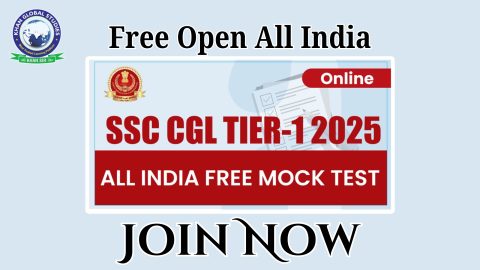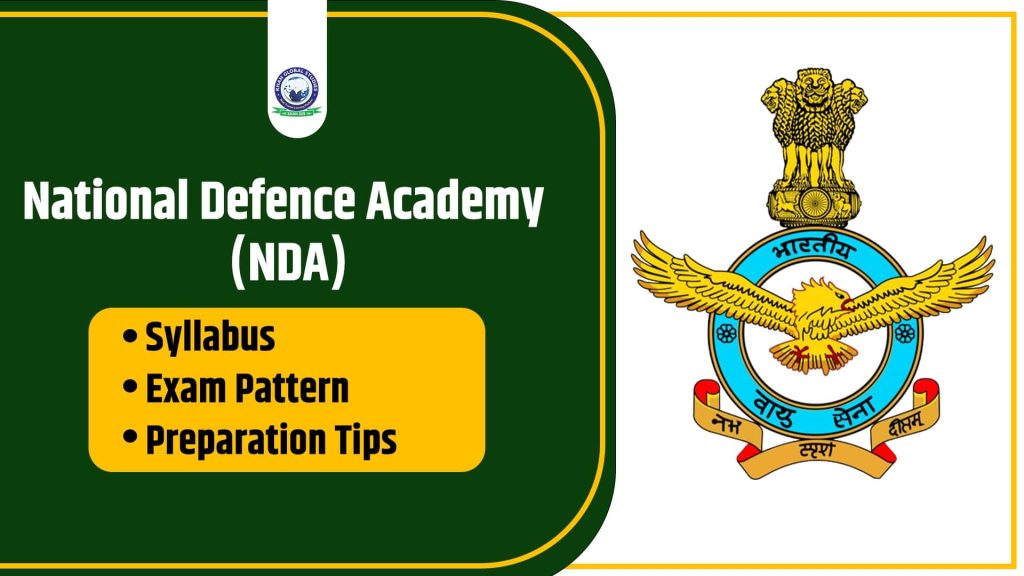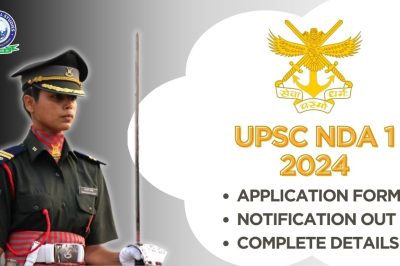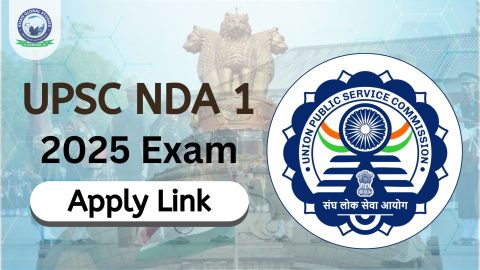NDA Syllabus 2024 has been released by the Union Public Service Commission (UPSC) with the official notification on its website. UPSC conducts the National Defence Academy Examination twice a year to recruit suitable male and female candidates for the defence forces of the country. Those who are going to appear in the upcoming exam should check the latest NDA syllabus and exam pattern of Mathematics, English and General Knowledge which is given here in detail. The syllabus consists of two papers, Mathematics and General Aptitude Test (GAT). 120 questions will be asked from the Mathematics section and 150 questions will be in the GAT paper.
NDA Syllabus and Exam Pattern Overview
| Conducted by | Union Public Service Commission (UPSC) |
| Exam Name | National Defence Academy (NDA) Exam |
| Frequency of Exam | Twice in a year |
| Mode of Exam | Offline |
| Selection Process | Written Test (Objective Type Questions) Intelligence & Personality Test (SSB) |
| Papers in NDA Exam | Mathematics (120 Questions – 300 Marks) General Ability Test (150 Questions – 600 Marks) |
| Negative Marking | ⅓ Mark for each wrong answer |
| Time Duration | 2.5 Hours (150 Minutes) for Each Paper |
| Application Fee | For General/OBC: 100/- For SC/ST: 0/- |
| Language of Question Paper | Hindi & English |
| Official Website | www.upsc.gov.in |
NDA Syllabus 2024
NDA Syllabus for Paper 1 (Mathematics)
| Subject | Topics |
| Algebra | Concept of set Operations on sets Venn Diagrams De Morgan Laws Cartesian product Relation Equivalence Relation Representation of Real Numbers on a line Complex Numbers — Basic Properties Modulus Argument Cube Roots of Unity Binary System of Numbers Conversion of a Number in a Decimal System to a Binary System and Vice-Versa Arithmetic, Geometric and Harmonic Progressions Quadratic Equations with Real Coefficients Solution of Linear Inequations of two variables by Graphs Permutation and Combination Binomial Theorem and its Applications Logarithms and their Applications |
| Matrices and Determinants | Types of matrices Operations on Matrices Determinant of a Matrix Basic Properties of Determinants Adjoint and Inverse of a Square Matrix Applications-Solution of a system of linear equations in two or three unknowns by Cramer’s rule and by Matrix Method. |
| Trigonometry | Angles and their measures in degrees and radians Trigonometrical Ratios Trigonometric Identities Sum and Difference formulae Multiple and Sub-multiple Angles Inverse Trigonometric Functions Applications- height and distance, properties of triangles. |
| Analytical Geometry of Two and Three Dimensions | Rectangular Cartesian Coordinate system Distance formula Equation of a line in various forms The angle between two lines Distance of a point from a line Equation of a circle in standard and a general form, Standard forms of parabola, ellipse, and hyperbola Eccentricity and axis of a conic point in a three-dimensional space, the distance between two points Direction Cosines and direction ratios Equation two points Direction Cosines and direction ratios Equation of a plane and a line in various forms The angle between two lines and the angle between two planes Equation of a sphere. |
| Differential Calculus | Concept of a real-valued function–domain, range, and graph of a function Composite functions, one-to-one, onto, and inverse functions The notion of limit, Standard limits—examples Continuity of functions—examples, algebraic operations on continuous functions Derivative of function at a point, geometrical and physical interpretation of a derivative—applications Derivatives of sum, product, and quotient of functions, a derivative of a function with respect to another function, a derivative of a composite function Second-order derivatives Increasing and decreasing functions Application of derivatives in problems of maxima and minima. |
| Integral Calculus and Differential Equation | Integration as inverse of differentiation Integration by substitution and by parts Standard integrals involving algebraic expressions Trigonometric, Exponential, and Hyperbolic Functions Evaluation of definite integrals—determination of areas of plane regions bounded by curves—applications Definition of order and degree of a differential equation Formation of a differential equation by examples General and particular solutions of differential equations Solutions of the first order, and first-degree differential equations of various types—examples Application in problems of growth and decay. |
| Vector Algebra | Vectors in two and three-dimensions Magnitude, and direction of a vector Unit and null vectors The addition of vectors Scalar multiplication of a vector Scalar product, or dot product of two vectors Vector product or cross product of two vectors Applications—work done by a force and moment of a force and in geometrical problems. |
| Statistics and Probability | Statistics: Classification of data Frequency distribution Cumulative frequency distribution—examples Graphical representation—Histogram Pie Chart Frequency polygon— examples Measures of Central Tendency—Mean Median, and mode Variance and standard deviation—determination and comparison Correlation and regression. Probability: Random experiment Outcomes, and associated sample space Events Mutually exclusive and exhaustive events Impossible and certain events Union and Intersection of Events Complementary, elementary, and composite events Definition of probability—classical and statistical—examples Elementary theorems on probability—simple problems Conditional probability Bayes’ theorem—simple problems Random variable as function on a sample space Binomial distribution |
NDA Syllabus for Paper 2 (General Ability Test)
NDA Paper 2 consists of two parts:
- Part A: English (Maximum 200 Marks)
- Part B: General Knowledge (Maximum 400 Marks)
Part A Syllabus: English
The question paper in English will be designed to test the candidate’s understanding of English and workman-like usage of words. The course covers various aspects such as grammar and usage, vocabulary, comprehension and cohesion in extended text to test the candidate’s proficiency in English.
Part B Syllabus: General Knowledge
The General Knowledge question paper will broadly cover the subjects: Physics, Chemistry, General Science, Social Studies, Geography and Current Events. – The syllabus of the table below is designed to indicate the scope of the topics covered in this paper.
| Subject | Topics |
| Section A: Physics | Physical Properties and States of Matter Mass, Weight, Volume, Density and Specific Gravity Principle of Archimedes, Pressure Barometer The motion of objects, Velocity, and Acceleration Newton’s Laws of Motion, Force and Momentum Parallelogram of Forces, Stability and Equilibrium of bodies Gravitation, elementary ideas of work, Power, and Energy Effects of Heat, Measurement of Temperature and Heat change of State and Latent Heat, Modes of Transference of Heat Sound waves and their properties, Simple musical instruments Rectilinear propagation of Light, Reflection, and refraction Spherical Mirrors and Lenses, Human Eye Natural and Artificial Magnets, Properties of a Magnet, Earth as a Magnet Static and Current Electricity Conductors and Non-conductors Ohm’s Law, Simple Electrical Circuits, Heating Lighting and Magnetic effects of Current, Measurement of Electrical Power Primary and Secondary Cells, and Use of X-RaysGeneral Principles in the working of the following: Simple Pendulum, Simple Pulleys, Siphon, Levers, Balloon, Pumps, Hydrometer, Pressure Cooker, Thermos Flask, Gramophone, Telegraphs, Telephone, Periscope, Telescope, Microscope, Mariner’s Compass; Lightening Conductors, Safety Fuses. |
| Section B: Chemistry | Physical and Chemical changes Elements, Mixtures and Compounds, Symbols Formulae and Simple Chemical Equations Law of Chemical Combination (excluding problems) Properties of Air and Water. Preparation and Properties of Hydrogen, Oxygen, Nitrogen, and Carbon dioxide, Oxidation and Reduction. Acids, bases, and salts. Carbon—different forms. Fertilizers—Natural and Artificial. The material used in the preparation of substances like Soap, Glass, Ink, Paper, Cement, Paints, Safety Matches, and Gun Powder. Elementary ideas about the structure of Atoms, Atomic Equivalent and Molecular Weights, and Valency. |
| Section C: General Science | Difference between living and non-living. Basis of Life—Cells, Protoplasms, and Tissues. Growth and Reproduction in Plants and Animals. Elementary knowledge of the Human Body and its important organs. Common Epidemics, their causes, and prevention. Food—Source of Energy for man. Constituents of food, Balanced Diet. The Solar System—Meteors and Comets, Eclipses. Achievements of Eminent Scientists. |
| Section D: History, Freedom Movement etc. | A broad survey of Indian History, with emphasis on Culture and Civilisation. Freedom Movement in India. Elementary study of Indian Constitution and Administration. Elementary knowledge of Five Year Plans of India. Panchayati Raj, Co-operatives and Community Development. Bhoodan, Sarvodaya, National Integration and Welfare State, Basic Teachings of Mahatma Gandhi. Forces shaping the modern world; Renaissance, Exploration, and Discovery; War of American Independence. French Revolution, Industrial Revolution, and Russian Revolution. Impact of Science and Technology on Society. Concept of one World, United Nations, Panchsheel, Democracy, Socialism, and Communism. Role of India in the present world. |
| Section E: Geography | The Earth, its shape and size. Lattitudes and Longitudes, Concept of time. International Date Line. Movements of Earth and their effects. Origin of Earth. Rocks and their classification; Weathering—Mechanical and Chemical, Earthquakes and Volcanoes. Ocean Currents and Tides Atmosphere and its composition; Temperature and Atmospheric Pressure, Planetary Winds, Cyclones and Anti-cyclones; Humidity; Condensation and Precipitation; Types of Climate, Major Natural Regions of the World.Regional Geography of India—Climate, Natural vegetation. Mineral and Power resources; location and distribution of agricultural and Industrial activities. Important Sea ports and main sea, land, and air routes of India. Main items of Imports and Exports of India. |
| Section F: Current Events | Knowledge of Important events that have happened in India in recent years. Current important world events. Prominent personalities—both Indian and International including those connected with cultural activities and sports. |
NDA Exam Pattern
Candidates who are preparing for the NDA Exam must be familiar with the exam pattern followed by UPSC. We have discussed the details of the NDA 2024 exam pattern below:
- The examination will be conducted in offline mode
- Questions will be multiple-choice questions
- Questions will be asked in English & Hindi both languages
| Paper | No. of Questions | Negative Mark | Maximum Marks | Time Duration |
| 1 (Mathematics) | 120 | 0.83 Mark | 300 | 2.5 Hours |
| 2 (General Ability Test) | 150 | 1.3 Mark | 600 | 2.5 Hours |
Intelligence and Personality Test
The SSB process involves two stages of selection processes – Stage I and Stage II. Only those candidates who qualify for Phase I are allowed to appear for Phase II. The details are:
- Stage I consists of Officer Intelligence Rating (OIR) tests – Picture Perception*Description Test (PP&DT). Candidates will be shortlisted based on a combination of performance in the OIR Test and PP&DT.
- Stage II consists of an Interview, Group Testing Officer Task, Psychology Test and Conference. These tests are conducted over 4 days. The details of these tests are given on the website joinindianarmy.nic.in.
NDA Eligibility Criteria
Candidates must have the minimum qualifications to be eligible for defence Jobs. Below we have mentioned the details of education qualification, age limit, nationality and physical standards.
Educational Qualification
- For Army Wing of National Defence Academy:- 12th class passed from 10+2 pattern of school education or equivalent examination conducted by a State Education Board or University.
- For Air Force and Naval Wings of the National Defence Academy and the 10+2 Cadet Entry Scheme at the Indian Naval Academy:- 12th class passed or equivalent with Physics, Chemistry and Mathematics of 10+2 pattern of school education. By any State Education Board or University.
Candidates who are appearing for the 12th class or equivalent examination under the 10+2 pattern of school education can also apply for this examination.
Age Limit
According to UPSC, the age of the candidate should be 16½ to 19½ at the time of joining.
Nationality
The Candidate must be an unmarried man/woman and must be:
- a citizen of India, or
- a subject of Nepal, or
- A person of Indian origin who has come from Pakistan, Burma, Sri Lanka and the East African countries of Kenya, Uganda, the United Republic of Tanzania, Zambia, Malawi, Zaire and Ethiopia or Vietnam intending to permanently settle in India.
Tips for NDA Exam Preparation:
Achieving success in the NDA exam requires a well-structured preparation plan. Here are some valuable tips:
- Understand the Syllabus: Familiarize yourself with the NDA syllabus to know what topics to focus on.
- Create a Study Schedule: Develop a comprehensive study schedule that covers all subjects, allowing you to manage time efficiently.
- Practice Regularly: Solving previous years’ question papers and taking mock tests to enhance your time management and accuracy.
- Physical Fitness: NDA not only tests your mental abilities but also your physical fitness. Engage in regular exercise and maintain a healthy lifestyle.
- Stay Informed: Keep up with current affairs, especially issues related to defence and national security.
- Join a Coaching Institute: Enroll in a reputable coaching institute to receive guidance and expert tips.
- Self-Study: Complement your coaching with self-study. Review and revise regularly.
Tips for the SSB Interview
The SSB interview is a critical component of the NDA selection process. Here are some tips for the interview phase:
- Confidence: Be confident in your responses. SSB assesses your personality and leadership qualities.
- Communication Skills: Effective communication is essential. Practice expressing your thoughts clearly and logically.
- Positive Body Language: Maintain good posture and eye contact. Your body language should convey confidence and determination.
- Problem-solving: Be prepared for situational and group discussions. Practice problem-solving with a rational approach.







